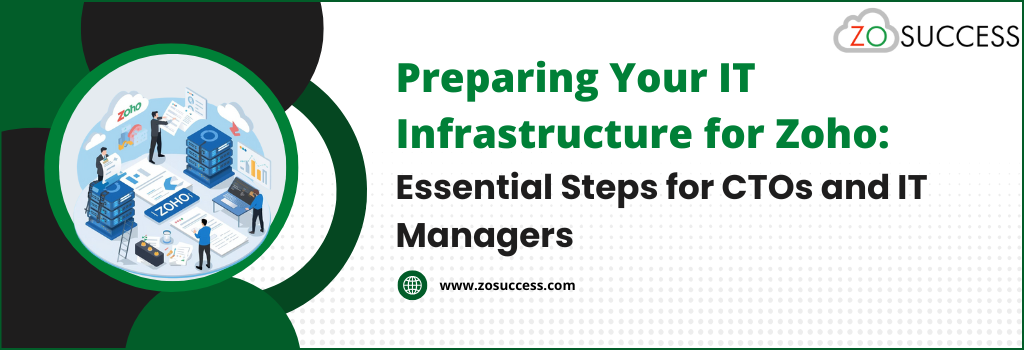
Implementing a cloud-based business suite like Zoho can transform the way your organization operates, streamlining workflows, improving collaboration, and driving growth. However, the success of your Zoho deployment heavily depends on the readiness of your IT infrastructure. For CTOs, IT Managers, and technology leaders, proactive planning and careful execution are critical to ensure a smooth, secure, and scalable implementation.
Why IT Readiness Matters for Zoho Success
Zoho offers a comprehensive suite of cloud-based applications, including CRM, finance, HR, project management, analytics, and more. While the software is intuitive and user-friendly, the underlying IT infrastructure must be prepared to handle its technical demands.
Key reasons IT readiness is essential:
- Smooth Deployment: Ensuring servers, networks, and devices are optimised reduces the risk of downtime or slow performance during and after implementation.
- Data Integrity: Proper planning minimises errors during migration, ensuring your data remains accurate, complete, and accessible.
- Security and Compliance: Zoho handles sensitive business data; a robust infrastructure protects against breaches and regulatory non-compliance.
- Future Scalability: A prepared IT ecosystem supports business growth without requiring disruptive reconfiguration.
CTOs and IT Managers play a pivotal role in this process, providing strategic oversight, leading technical teams, and coordinating cross-department collaboration to ensure Zoho deployment aligns with organizational objectives.
Essential Steps for CTOs and IT Managers
Step 1: Evaluate Your Current IT Environment
Before implementing Zoho, start with a thorough assessment of your existing IT environment:

- Audit hardware, software, and network components to identify what can be leveraged and what needs upgrading.
- Examine integration points with legacy systems, such as ERP or HR software, to ensure seamless connectivity.
- Identify performance gaps, outdated equipment, or unsupported operating systems that could hinder Zoho’s functionality.
- Document system dependencies, potential risks, and constraints to create a clear migration roadmap.
Tip: Involving department heads in this evaluation can uncover hidden dependencies that may affect deployment.
Step 2: Strengthen Network and Connectivity
Zoho’s cloud-based applications rely on fast, stable internet connections. Poor network performance can lead to slow loading times, failed data syncs, and frustrated users.
Actionable measures:
- Ensure reliable high-speed internet for all users, including remote or hybrid teams.
- Configure firewalls, VPNs, and security policies to allow safe access without blocking necessary Zoho services.
- Optimize bandwidth allocation to prevent congestion during peak usage periods.
- Conduct latency and uptime tests to identify potential bottlenecks.
Pro Tip: Consider using network monitoring tools to continuously assess performance after deployment.
Step 3: Prepare Hardware and End-User Devices
Zoho runs on desktops, laptops, tablets, and mobile devices, so device readiness is crucial:
- Define minimum hardware specifications to ensure smooth performance across all Zoho applications.
- Upgrade outdated devices to support modern browsers, faster processors, and adequate memory.
- Enable cross-platform compatibility for teams using Windows, Mac, iOS, or Android devices.
- Ensure all devices comply with company security policies, operating system updates, and antivirus protection.
Example: A sales team using mobile CRM apps will require reliable tablets or smartphones to access Zoho CRM in real-time.
Step 4: Develop a Robust Data Management Strategy
Data migration is one of the most critical phases of a Zoho implementation. A solid data strategy ensures your business information remains accurate, secure, and usable.
Key actions:
- Audit and cleanse existing data to remove duplicates, incomplete entries, or outdated records.
- Map current data structures to Zoho modules to prevent mismatches during migration.
- Create a secure migration plan with backup checkpoints to safeguard against errors.
- Verify post-migration data integrity to confirm all information is accurately transferred.
Pro Tip: Test the migration process on a smaller dataset first to identify potential issues before full-scale deployment.
Step 5: Strengthen Security and Compliance Controls
With Zoho managing critical business processes, robust security measures are non-negotiable:
- Implement multi-factor authentication (MFA) and encryption to protect user accounts and sensitive data.
- Establish role-based access controls to limit access to sensitive modules and administrative functions.
- Ensure compliance with GDPR, SOC 2, HIPAA (if applicable), and local data privacy regulations.
- Monitor audit logs to detect suspicious activities and maintain accountability.
Tip: Security protocols should be regularly reviewed and updated to address emerging threats.
Step 6: Plan for System Integrations
Zoho works best when integrated seamlessly with other enterprise systems. Planning integrations reduce disruptions and ensure business continuity:
- Identify key integrations, including ERP, HRMS, finance software, and analytics tools.
- Use Zoho Flow, APIs, or third-party connectors to maintain real-time data synchronisation.
- Conduct end-to-end testing to ensure integrations perform correctly before going live.
- Maintain version control and integration documentation for future troubleshooting.
Example: Syncing Zoho CRM with your ERP ensures accurate, real-time sales order and inventory updates.
Step 7: Build for Scalability and Cloud Optimization
A future-ready IT infrastructure supports growth and changes in business needs:
- Evaluate server and cloud capacity to handle increased users and data volume.
- Leverage Zoho’s cloud scalability to expand access across departments or regions.
- Plan modular roll-outs to introduce applications in phases, reducing risk and easing adoption.
- Optimize configurations for performance while keeping cloud costs under control.
Tip: Track usage patterns to anticipate when additional resources or subscriptions are needed.
Step 8: Establish Identity and Access Management (IAM)
Managing users efficiently ensures security and smooth access:
- Implement Single Sign-On (SSO) to simplify authentication for employees.
- Define role-based access policies to align permissions with job responsibilities.
- Automate user provisioning and deactivation to reduce manual errors.
- Monitor login activity to identify suspicious behaviour or potential security breaches.
Step 9: Set Up Backup and Disaster Recovery Systems
Data continuity is essential for business resilience:
- Schedule automated backups of all Zoho data to avoid accidental loss.
- Store backup copies in secure and compliant cloud environments, separate from your primary system.
- Periodically test disaster recovery processes to confirm operational readiness.
- Document recovery protocols so IT and business teams can respond efficiently in emergencies.
Pro Tip: Include regular restore drills in IT maintenance schedules to ensure preparedness.
Step 10: Test Infrastructure Performance and Reliability
Before full deployment, validate that your infrastructure can support real-world workloads:
- Conduct pilot runs simulating actual business operations.
- Monitor system response times, resource usage, and performance metrics.
- Gather feedback from test users to identify issues or areas of improvement.
- Adjust configurations based on insights to maximize reliability and speed.
Step 11: Train IT Teams and End Users
Effective training drives user adoption and reduces support requests:
- Provide Zoho admin and technical training for IT staff to manage the platform efficiently.
- Create user guides, FAQs, and step-by-step instructions for end users.
- Conduct live workshops and hands-on sessions to build familiarity and confidence.
- Establish ongoing support channels to address queries post-deployment.
Tip: Gamify training sessions to increase engagement and retention.
Step 12: Monitor, Audit, and Continuously Improve
IT infrastructure and Zoho systems require ongoing oversight:
- Set up dashboards for real-time monitoring of system health and usage.
- Conduct quarterly audits to detect performance issues or bottlenecks.
- Analyse resource usage, login activity, and workflow efficiency metrics.
- Implement continuous improvement based on insights to optimize both cost and performance.
Best Practices for CTOs and IT Managers
- Engage all departments early to align on implementation goals and expectations.
- Partner with certified Zoho consultants for smooth setup and migration.
- Maintain thorough documentation of system configurations, integrations, and policies.
- Stay informed about Zoho updates and feature releases to remain ahead of changes.
Conclusion: Building a Future-Ready IT Foundation
A successful Zoho implementation begins with a prepared IT infrastructure. From network readiness and hardware upgrades to security, integrations, and user training, each step ensures seamless deployment, data integrity, and long-term scalability. Proactive planning empowers CTOs and IT Managers to transform IT from a support function into a strategic enabler of business growth.
By investing time and effort upfront, organizations can harness the full potential of Zoho’s cloud suite, delivering enhanced efficiency, collaboration, and measurable business value.
Get Your Free Zoho IT Readiness Assessment Our experts at ZoSuccess can audit your IT ecosystem, identify readiness gaps, and guide you through a seamless Zoho implementation. Contact us today to schedule your IT readiness consultation and start building a future-ready IT foundation.


 “ZOSuccess” is the Zoho Consulting Practice of Dhruvsoft Services Private Limited – a leading Zoho Advanced Partner from India – providing services worldwide …
“ZOSuccess” is the Zoho Consulting Practice of Dhruvsoft Services Private Limited – a leading Zoho Advanced Partner from India – providing services worldwide …